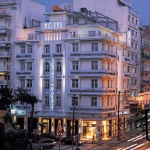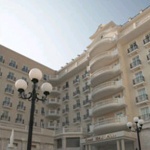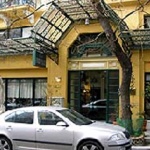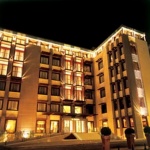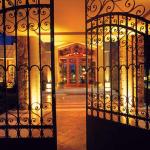Sights Thessaloniki, Greece
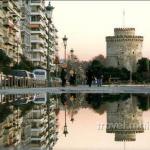 Thessaloniki (in Greek "Salonika") was founded in 315 BC on the site of the ancient settlement "thermo" Macedonian king Cassander, who gave the city a new name - the name of his wife and sister of Alexander of Macedonia - Thessaloniki.
Thessaloniki (in Greek "Salonika") was founded in 315 BC on the site of the ancient settlement "thermo" Macedonian king Cassander, who gave the city a new name - the name of his wife and sister of Alexander of Macedonia - Thessaloniki.History of founding of the city of Thessaloniki is the story of personification of power and glory of the Macedonian dynasty. Here the Apostle Paul first heralded the dawn of Christianity, this city was once chosen as his residence the Roman emperor Galerius; here because of faith in Christ was martyred warrior Demetrius, who was deeply revered saint. Hence, the brothers Cyril and Methodius undertook its ambitious mission of Christianization of the Slavic peoples.
The city has repeatedly been subjected to invasions of different tribes and nationalities, but after each raid risen even more beautiful, dressed in ancient Byzantine mantle, it is designed.
Evidence of a glorious 23-X centuries of history are its monuments: the Church of St. Demetrius, built in the style of the basilica, part of the fortress walls, the Rotunda with its wonderful mosaic paintings, Arch of Roman emperor Galleries, Archaeological Museum with an exhibition of the treasures of the tomb of the king of Macedonia Philip II.
Just 8 km from Thessaloniki for several years now operates one of the biggest attractions in Europe - WATERLAND. This place has the largest pool in Europe (3500 m2.) With artificial waves and automatic control system of water filtration.
Thessaloniki - the most convenient starting point for many excursions in Northern Greece. You can visit the archaeological site of ancient capital of Macedonia Vergina and Pella. Pella - the capital of the Macedonian kingdom in 413-399 years. BC birthplace of Alexander of Macedon. In addition, situated near Chalkidiki, Mount Athos region, Kastoria.
The city has many students. Strolling in the evening on the promenade, you can see young people, filling bars and cafes. On the waterfront set a majestic monument to Alexander the Great, on behalf of the half-sister who named the city. She was the wife of the king of Cassandra, who in 315g. BC founded the city. After the Romans conquered Greece, the city became the capital of the province of Macedonia (146 BC) and an important point on the road under the name of Ignatius which bound Rome with its eastern outpost - Constantinople.
The main street of the city today is still called Ignatius. Near the street arch of the Emperor Galerius, built in 303 under Emperor Galerius (d. 313 AD) to commemorate his victory over the Persians. The arch is covered with bas-reliefs depicting the exploits Gallery. Next to it stands the Rotunda, which was to serve as a mausoleum Gallery, at different times and used as a church and a mosque, but today there are organized temporary exhibitions.
White Tower. Located in the Upper town, climb the tower, where a beautiful view over the city. The tower is a link now partially lost the Byzantine city walls, remains of which can be seen somewhere in the area. Here is the White Tower - a popular symbol of the city. Once it was called the bloody tower, because it served as a prison and place of execution. Today it is the Byzantine Museum, which housed a rather eclectic collection of objects of Byzantine culture, including mosaics, jewelry, icons.
Museums in Thessaloniki
It is within walking distance to the Archaeological Museum - one of the attractions of the city. Some of the exhibits date from the Neolithic and Iron Age, and suggest that Macedonia was among the areas of Greece where there were first settlement. In a specially built wing at the end of a long corridor placed the remains of the king of Macedonia Philip II, there is a gold coffin, where he was buried, and many other great items discovered in the royal tomb at Vergina. Among them are figures of ivory members of the royal family, a golden crown and armor, in which Philip was wearing. In the same room with the objects the excavation site, north of the city Derveni. The most interesting finds are exhibited here, so a trip to the site of excavation will not be so interesting. Among the masterpieces - the charred remains of papyrus IV century, a huge crater of Derveni height of one meter - a richly decorated bronze vessel used for mixing wine with water. The museum presents several mosaics, found mainly in the Roman houses in the city. They were the floor and wall decoration of Roman houses. Pay attention to the mosaic picture of three horses.
Should visit and small museums. Ethnographic museum is placed in the building of the XIX century to the east of the city center. It is a collection of national costume, an extensive photo archive, and many other interesting exhibits. Closer to the waterfront and the center of Thessaloniki is the Museum of the Macedonian battle. Territorial claims of the former Yugoslav Republic of Macedonia in Greece cause of great concern, especially with respect to the area, which is traditionally regarded as the true Macedonia. The exhibits of this museum: photographs, documents, weapons, fighters for the freedom of Greece, colorful dioramas - are familiar with the position of Greece on the origin of this territory.
Church
In Thessaloniki, a lot of churches. In the center of town is the church of St. Sophia (Ayiya Sophia), built in VIII century. It is easy to learn because it is similar to Hagia Sophia in Istanbul. This church in Thessaloniki in the period from 1585 to 1912. was converted into a mosque. Pay attention to the foundations of the minaret has survived in one corner of the church, as well as the frescoes and mosaics that have survived from the IX-X centuries.
Thessaloniki can be justifiably proud of one of the largest cathedrals in Greece - Agios Dimitrios, named after the patron saint of the city of St. Demetrios. This - the building, newly built in 1917 to replace the old basilica, burned in a fire that destroyed much of the city. The basilica stands on the spot where in 305, the Romans executed St. Demetrios for refusing to renounce the faith. Until now, there is the crypt (crypt), where these events occurred. Every year on October 26 in honor of St. Demetrius holds festive processions and services. In the upper town look for a small chapel of St. David (V century), in which the altar is one of the beautiful mosaics of Thessaloniki "Vision of Ezekiel. The chapel is usually closed, but you can find a supervisor and ask to open the doors for inspection.
Beaches
At the coast of Thessaloniki placed wide sandy beaches, which stretch for miles. Small town will pick you up an exotic bay on the coast which settled comfortably modern hotels of different levels. Amenities included all the necessary conditions to all sorts of entertainment and water sports. This amazing corner of the Mediterranean Sea is perfect for the order to be fully worthy of the time and relax with your family.
Entertainment
The modern infrastructure of the city of Thessaloniki has included all the conditions for meaningful and unforgettable holiday, both from families with children and romantic couples. Here, before you open endless possibilities diving, surfing and underwater diving. For children on the island there are four water park. Each of them included a large number of different water slides, thrilling rides and swimming pools with artificial waves. Various tours of ancient sights of the island will bring much pleasure and admiration of the ancient civilization of the country.
Nightlife
Nightlife in Thessaloniki, the rich and interesting. The resort will offer you to visit the cozy restaurants of the highest category in which you can taste delicious dishes of Greek cuisine and taste the extensive wine list of famous brands. In Thessaloniki, the youth can noisily merry at the Athens bars, discos or nightclubs, where you are given a huge range of different alcoholic drinks and cocktails under a noisy modern music and exciting shows.
